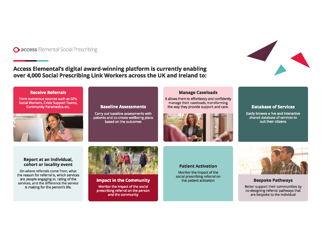What are health inequalities and how to reduce them?
Causes of health inequalities in the UK are numerous and varied. This makes tackling and reducing health inequalities a complex challenge requiring the collective action of different organizations and stakeholders.
If you work in health, or care, a similar service or a local authority, you’ll already understand this. You’re probably in search of new or additional approaches and crucially which of them really work.
Firstly, local authorities and health and social care professionals need to know and understand the cause of health inequalities and how they affect the community. Without this knowledge, putting strategies in place to reduce health inequalities could be a waste of time and money.
But what are health inequalities and what’s the difference between health disparities and health inequalities?
Access Elemental Social Prescribing
At Access Elemental Social Prescribing, we know and understand what health inequalities are and how they can impact an individual’s mental health and wellbeing. Through digital social prescribing, we’ve come to work with health, care, and related organisations everywhere, to tackle health inequalities and help ensure there is equal access to health and social care as well as any additional services within a community, to not only improve an individual’s health and wellbeing but their communities too. This has given us a deep understanding of the issues that I’m going to share with you.
By the end of this article, you will have a much better understanding of health inequalities, their causes of them, and strategies to tackle and reduce health inequalities so every individual in a community has easy access to the services they need regardless of their background.
We know that to do this a co-production approach is needed to ensure your community has the best population health management possible, so no one is left without the support they need or the support which matters to them.
Jump to section:
- What are health inequalities?
- Difference between health disparities and health inequalities – what are they?
- Causes of health inequalities – what are they?
- How do health inequalities impact health and wellbeing?
- Reducing health inequalities – What are the strategies?
- Strategies to reduce health inequalities – how can social prescribing help?
- Summarising the importance of tackling health inequalities
What are health inequalities?
Health inequalities are the differences in health outcomes which are avoidable, unfair, and systematic between different groups of people. Regardless of where you are from there are always wide disparities in the health status of different social groups.
Health inequalities happen because of the conditions which we are born in, grow up in, live in and work in. These conditions influence our opportunities for good health shaping both an individual’s physical and mental health as well as individual’s wellbeing.
Often the lower an individual’s socio-economic position the higher the risk of poor health. Health inequalities can be experienced by people grouped by a range of different factors including socioeconomic status and deprivation, sharing certain protected characteristics, belonging to vulnerable or excluded groups of society, or someone’s geography.
These factors can be complex and interact with each other to both benefit and disadvantage people or groups leading to different outcomes. In most cases, these factors can overlap meaning that people experiencing the effects of an inequality may experience multiple drivers of poor health at the same time.

Difference between health disparities and health inequalities – what are they?
Both health disparities and health inequalities are related concepts which are sometimes used interchangeably despite the clear distinctions between the two.
Health disparities and health inequalities are actually related concepts, but there are key differences between the two that are worth noting.
Health disparities, for example, refer to the differences in both health outcomes and access to healthcare services between different population groups. Normally they are described as unjust or avoidable and often they can be influenced by various factors such as ethnicity, race, socioeconomic status, gender, and geographic location to name a few. These disparities often cause differences in disease prevalence, quality of care delivered, and health outcomes amongst different demographic groups.
Health inequalities, however, encompass a broader concept by referring to avoidable differences in health within different population groups. Like health disparities it can include disparities in health outcomes, but it also can include differences in access to healthcare, the social determinants of health, as well as the living conditions of different populations and how they can influence health.
It is clear therefore that health disparities primarily focus on health-related differences, whereas health inequalities analyses a wider range of factors that contribute to unequal health status. Both acknowledge the importance of addressing and reducing these disparities in order to achieve better health and wellbeing for all individuals across different communities and population groups.
Causes of health inequalities – what are they?
As discussed above, health inequalities are complex and can arise from a combination of different factors. These factors will often overlap with one another and often are outside the control of the individuals themselves.
Some of the main causes of health inequalities include:
- Socioeconomic status
- The wider social determinants of health
- Health behaviours
- Psychosocial factors
- Race and ethnicity
- Geographic location
- Education
- Employment and occupation
- Health and Social Care access and quality
- Health and Social Care system
- Discrimination and bias
- Cultural and language barriers
1. Socioeconomic status
One of the most significant causes for health inequalities is socioeconomic status. Individuals with lower income levels often have limited access to healthcare, nutritious food, safe housing, and quality education. This in turn can impact their health by leading to longer waiting times to receive the care and support they require.
2. The wider social determinants of health
The wider social determinants of health can include several different things including income, education, housing, and access to services.
These determinants of health are normally not spread equally throughout the population. This in turn, results in some groups experiencing multiple disadvantages throughout their lives and others experiencing minimal disadvantages. This disparity therefore can widen the health inequalities further.
3. Health Behaviours

Another cause of health inequalities in the UK is health behaviours. To lead a healthy lifestyle, it is both influenced by the wider determinants of health and individual health behaviours. Health behviours can vary across the country and contribute further to health disparities.
Some of the health behaviours which can negatively impact someone’s health and widen health inequalities further are smoking, having a poor diet, being overweight, not exercising enough, or at all, and having a high alcohol consumption.
Often these behaviours follow in similar patterns to the wider determinants of health. Therefore, sometimes there can be a relationship between an individual’s likelihood of smoking, eating healthily, and engaging in regular physical activity and their social and environmental circumstances.
Another impact of health behaviours which can contribute to health inequalities further is health literacy. For example, if an individual has the appropriate skills, knowledge, and understanding of how to use health and social care information and services, the likelihood of them having better health behaviours is higher and the risk of their health declining will be lower.
4. Psychosocial factors
Psychosocial factors can be defined as the different exposures to social, economic, and environmental stressors and adversities one can experience in their lifetime. These factors tend to work alongside factors which relate to an individual’s ability to cope such as their personal resilience, self-efficacy, and their access to social networks.
Often these factors affect our state of mind from an early age and directly impact our resilience, health conditions, and health behaviours for later life, as well as increase the likelihood of further health inequalities developing.
5. Race and Ethnicity
Racial and ethnic minorities can frequently experience health inequalities such as the quality of care delivered, access to healthcare, and their health outcomes.
This can be due to both historic and systemic factors including discrimination and bias within the system.
6. Geographic location
Another factor of health inequalities is where people live. People living in rural or underserved areas can have reduced access to health and social care facilities and specialised medical services.
The limited access therefore can lead to disparities and inequalities in both access and its outcomes.
7. Education

Education is an example of another cause of health inequalities, where generally lower levels of education are associated with poorer health outcomes.
Having a limited education can result in a reduced health literacy and an awareness of the impacts different health behaviours can have on both your mental and physical wellbeing.
8. Employment and Occupation
Another cause of health inequalities can be occupational hazards and job-related stress. For example, lower waged jobs may lack benefits like health insurance making it difficult to access the healthcare an individual may need.
Additionally, high pressure jobs can cause job-related stress. If this is left unaddressed, individuals can be left with having to take time off work to recover for prolonged periods of time. For individuals that work in lower-paid jobs, this can result in a loss of jobs and more wider determinants of health that have to be dealt with, which can ultimately widen the health inequalities of an area further.
9. Health and Social Care Access and Quality
One of the main causes of health inequalities is the access and quality of health and social care services. Inequalities in access to health and social care services, insurance coverage, and the quality of care delivered can lead to differences in health outcomes.
Issues including costs, transportation, and language barriers can all limit someone’s access to the health and social care services available. Here more specific populations can have more limited access, widening the inequalities of a community further.
10. Health and Social Care System
Another cause of health inequalities is the health and social care system itself. Different areas of the country may be struggling with the different demands due to budgets and the workforce available. Uneven distribution of health and social care resources and workforce shortages can limit access to care and support for certain groups widening health inequalities further.
11. Discrimination and Bias
Discriminatory practices can impact health inequalities, they can be both explicit and implicit and lead to unequal treatment within health and social care settings. This in turn can affect diagnosis, treatment, and health outcomes which can widen health inequalities further in the long run.
12. Cultural and Language Barriers
A final cause of health inequalities is both cultural and language barriers. Having these barriers in place in both health and social care settings can hinder effective communication between individuals and health and social care professionals. This can ultimately impact the level of understanding individuals have about the health and social care information they have been provided and potentially the quality of care they have received.

Learn more about how Access Elemental Social Prescribing software can support you.
How do health inequalities impact health and wellbeing?
Health inequalities impact the health and wellbeing of individuals in a number of different ways. One way this can be measured is through analysing and comparing the life expectancies of different targeted groups.
The Health Foundation mapped out the average incomes against the average life expectancies across different areas in England. From their analysis they found that none of the areas in the north of England surpassed the above net annual income after housing costs for the country.
Manchester had the lowest life expectancy of 55.75 years with the third lowest average income of just over £19,800, whereas London had the second highest life expectancy of 70.85 years and the highest annual income of £52,000.
Individual’s life expectancies can decrease due to health inequalities as they impact different groups in a number of different ways. The list below demonstrates some of the ways health inequalities can impact both physical and mental health and wellbeing with examples:
-
Different health outcomes
Limited access to health and social care increases the likelihood of poorer health, increases rates of chronic diseases, and increases the likelihood of shorter life expectancies
-
Reduced quality of life
Quality of life can reduce due to illness, disability, and difficulties managing chronic conditions which can then lead to physical and psychological issues
-
Health and Social Care system strain
Health inequalities can add strain onto the already stretched health and social care system. This strain can overwhelm the system, further impacting the quality of care being delivered.
-
Health and Social Care Access
As discussed already, getting access to the help and support needed can cause great health inequalities. The impact of not being able to access the care needed can lead to symptoms and health outcomes worsening.
If individuals must wait for prolonged periods of time their mental health can also decline, and they can lose faith in the system for not being able to receive the care they need easily.
-
Health disparities cycle
Health inequalities can create a cycle of disadvantages. For example, individuals with poor health will often face greater barriers to education, employment, and mobility. Often this cycle can then pass down through generations.
-
Community Health
Health inequalities inevitably impact whole communities. Areas with lots of inequalities may experience lower community wellbeing, decreased economic opportunities, and potentially more social fragmentation.
-
Mental Health Impacts
If individuals face multiple health inequalities at the same time, they may experience mental health issues. These can include increased stress, anxiety, and depression due to their health and social care needs deteriorating.
-
Ethical and moral concerns
Finally, health inequalities also raise ethical and moral questions about fairness, justice, and societies' duties to ensure all individuals have equal opportunities to be able to maintain good health and wellbeing and have timely access to the support and tools they need for this to happen.
Reducing health inequalities – What are the strategies?
Currently, there are lots of new strategies and methods that are being introduced in order to tackle health inequalities. The impacts of the pandemic have led to many communities having their health inequalities widen, their demand for health and social care to increase, and waiting times soar.
To tackle this and help reduce health inequalities, in the past few years, the NHS has released several approaches, strategies, and models to encourage health and social care professionals to tackle health inequalities and improve outcomes both now and in the future.
1.Population intervention triangle
One of the methods that are encouraged is place-based approaches. It is thought these approaches provide tools and resources which support organsiations to work together to reduce health inequalities collaboratively.
The population intervention triangle therefore describes how local authorities and policymakers can work with the NHS and other supporting bodies to address health inequalities which can make a positive difference both now and in the future.
Through this approach stakeholders can use a co-production approach to best meet the needs of the targeted population.
2. The Core20Plus5 Approach
The Core20Plus5 approach has been designed to support Integrated Care Systems to drive targeted action in healthcare inequalities improvements.
The approach addresses that The Index of Multiple Deprivation has identified that 20% of the national population are the most deprived and that there are 5 key clinical areas of health inequalities. These include:
- Maternity
- Severe Mental Illness
- Chronic Respiratory Disease
- Early Cancer Diagnosis
- Hypertension Case-Finding
The ‘Plus’ part of this approach demonstrates that stakeholders also need to acknowledge there will be other population groups experiencing poorer than average health and outcomes that might not be captured within the Core20 alone, so these groups would then also benefit from more tailored health and social care.
This approach therefore has been created to help communities start to work together with other stakeholders to address these key health inequalities and ensure the right support is in place for each targeted group.
3. The National Healthcare Inequalities Improvement Program (HiQiP)
The National Healthcare Inequalities Improvement Program was established in January 2021 to tackle health inequalities post-pandemic and protect those at greatest risk. This improvement plan was established to work with other programmes and policy areas across NHS England as well as wider stakeholders including local authorities, care providers, and individuals themselves.
This program therefore is responsible for setting the direction for tackling health inequalities, by creating a positive improvement culture using data to target action to reduce and prevent further health inequalities from happening.
All three of these approaches put forward by the NHS all concentrate on three main things:
- Collaborative working
- Ensuring targeted action
- Offering equal opportunities
These three strategies therefore help local authorities organise better population health. Here communities can fully assess the needs of their community and understand where disparities are stronger to better understand what health inequalities need to be prioritised.
Concentrating on data and ensuring target action is a great way for your local authority to have a better population health management which continuously improves these health inequalities as well as prevent more from happening in the future, so every targeted group will have better timely access to the support they need when they need it.
There are also more ways health inequalities can be reduced by addressing the causes of health inequalities. Some of these include:
- Monitor and improve the quality of care delivered by targeting disadvantaged communities to reduce waiting times and barriers to care
- Implement more preventative measures such as promoting healthy lifestyles to support more vulnerable populations
- Train health and social care professionals to be more culturally competent and sensitive to the needs of diverse populations
- Invest in providing more accessible mental health support to reduce the stigma around mental health
- Deliver programs and interventions for childhood and early years to educate and improve health literacy as well as emotional wellbeing

Strategies to reduce health inequalities – how can social prescribing help?
Social prescribing is a great opportunity to help ensure everyone has better access to the health and social care services they need. Sometimes referred to as community referrals, social prescribing is an approach that has been embedded in the NHS’ Long Term Plan to refer people to non-clinical services in their area to best meet their needs and support their health and wellbeing.
Social Prescribing Link Workers play a critical role in helping to reduce health inequalities as they help empower and enable targeted groups who would otherwise would have had their needs unmet. As the social determinants of health account for 80% of all health outcomes, social prescribing offers a holistic approach to wellbeing by placing the control of managing someone’s health and wellbeing with the individual themselves so they can make better-informed decisions about their health and wellbeing.
Not only can social prescribing help reduce health inequalities now it can also help reduce them in the future by providing individuals with the tools in how to better manage their health and wellbeing. Individuals can be referred to interventions and services which matter to them whilst also ensuring that all their needs are met.
At Access Elemental Social Prescribing, we like to help organisations go one step further and be able to manage both referrals and the data collected more efficiently. This in turn ensures that individuals get referred on safe and assured pathways.
Through being the PRSB’s first official social prescribing partner our solution helps to offer all tools to help ensure your organisation is conformant to the new social prescribing standards. This in turn can help reduce the demand for primary care networks leading to cost savings in the long run to reinvest into services to reduce health inequalities further.
Across all the projects we have worked with at Access Elemental we have seen 65% of patients that have been engaging in social prescribing have reduced their number of GP appointments post-intervention. Healthy Options, for example, saw a 26% reduction in unscheduled care attendance and a saving of over £8,000 due to the reductions in GP attendance they saw alone.
The benefits of having all data and information consistently recorded in one place allows a better co-production approach with stakeholders across the community to address the health inequalities in the area so patterns can be identified to understand targeted populations more clearly.
Time is then saved from re-keying the same information across various spreadsheets, so more time can be spent tackling health inequalities further to improve your population health management which is essential for PCNs, reduce dependency on GPs, and save money in the long run, whilst having a happier and healthier community that provides all individuals access to the care and support they need regardless of their background.
Summarising the importance of tackling health inequalities
This article has reviewed what health inequalities are and their root causes to explain the different methods, strategies, and approaches which are being used across health and social care to tackle them.
I have explained how there are several different factors that can cause health inequalities or cause pre-existing ones to widen further and how for many places across the UK the impacts of the pandemic did widen a lot of these inequalities significantly.
Through describing the difference between health disparities and health inequalities this article has been able to explain how health inequalities can be measured by comparing the life expectancies of different populated groups across different areas.
This article has also explained how there are several different approaches being pushed, encouraged, and established by NHS England to encourage a co-production approach where different stakeholders can work together to tackle these health inequalities by delivering targeted action.
There are several different strategies which can be used. Following a population health management approach and adopting the social prescribing model are great ways to ensure no population or group is left without their needs unmet.
Through following these approaches individuals can also increase their independence by being able to manage their own health and wellbeing more effectively and gain better timely access to the care and support they need to improve their quality of life and their health outcomes.
At Access Elemental Social Prescribing, we know that social prescribing works and the benefits it can have on the individual and the community as a whole. We are passionate about helping communities and organisations consistently improve their outcomes to improve their community’s overall health and wellbeing, as well as be able to secure future funding to grow even further.
Our social prescribing platform allows stakeholders to work together to deliver targeted action so no one is left with their needs unmet or have their mental health decline due to longer waiting times. At Access Elemental we provide 100% buy-in interoperability across all PCNs to help manage your community’s population health management better to address the health inequalities in your area more proactively.
Find out more about how our social prescribing system can help your community today. Contact us and find out how we can help your community adopt social prescribing, so it best meets your community’s needs to deliver targeted action and ensure every individual has equal access and opportunities to the services available to maintain and improve their health and wellbeing.





